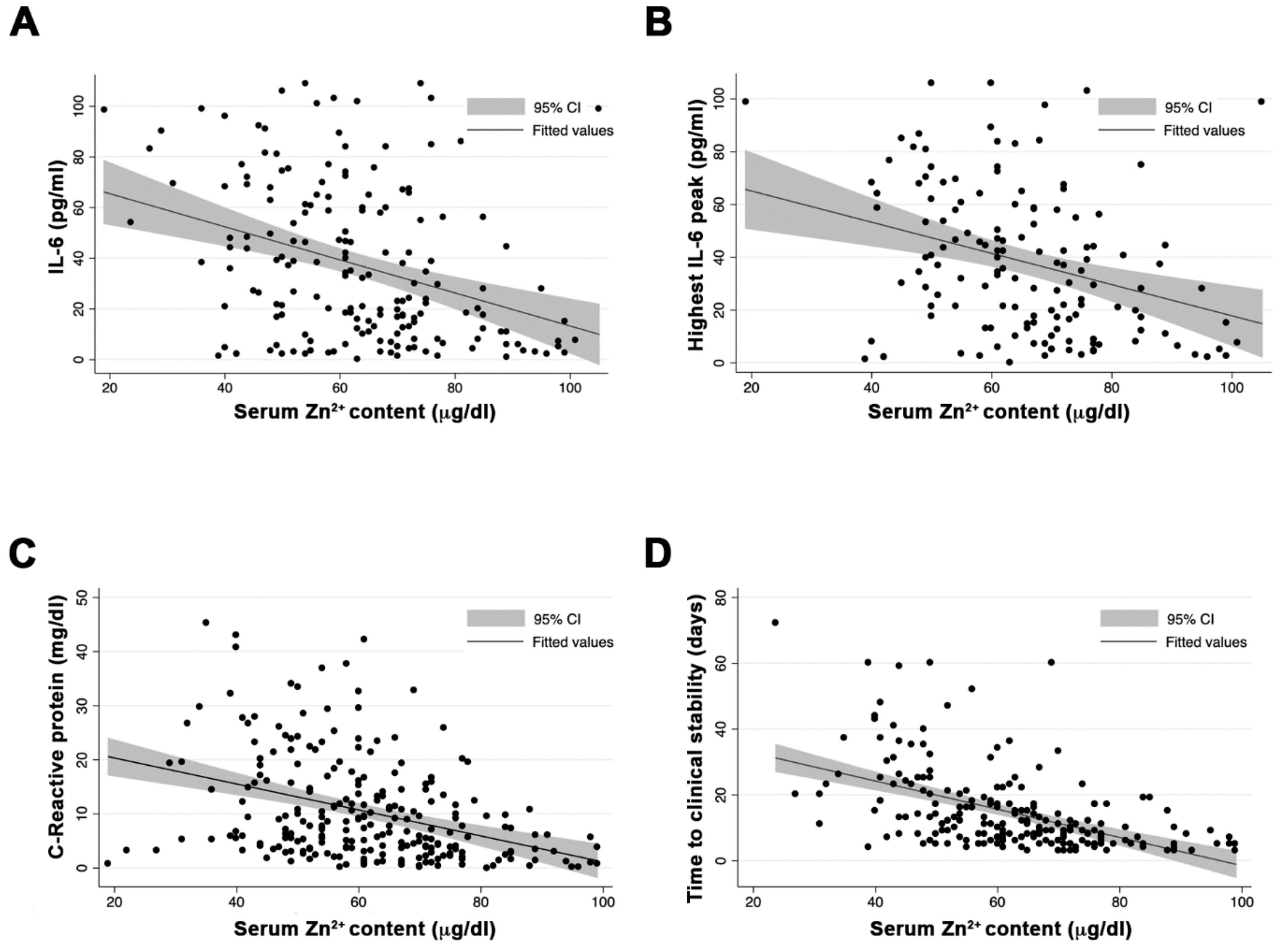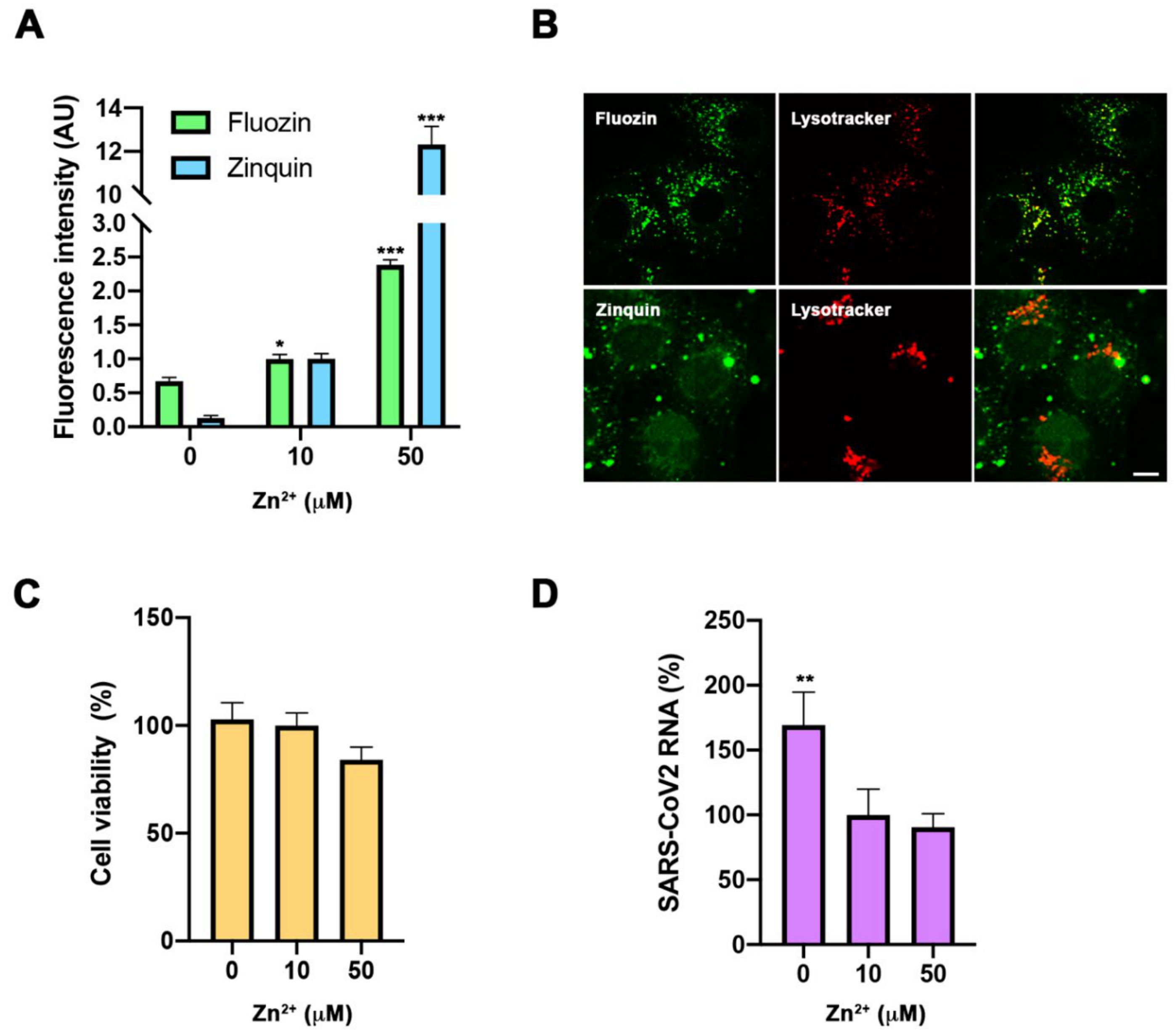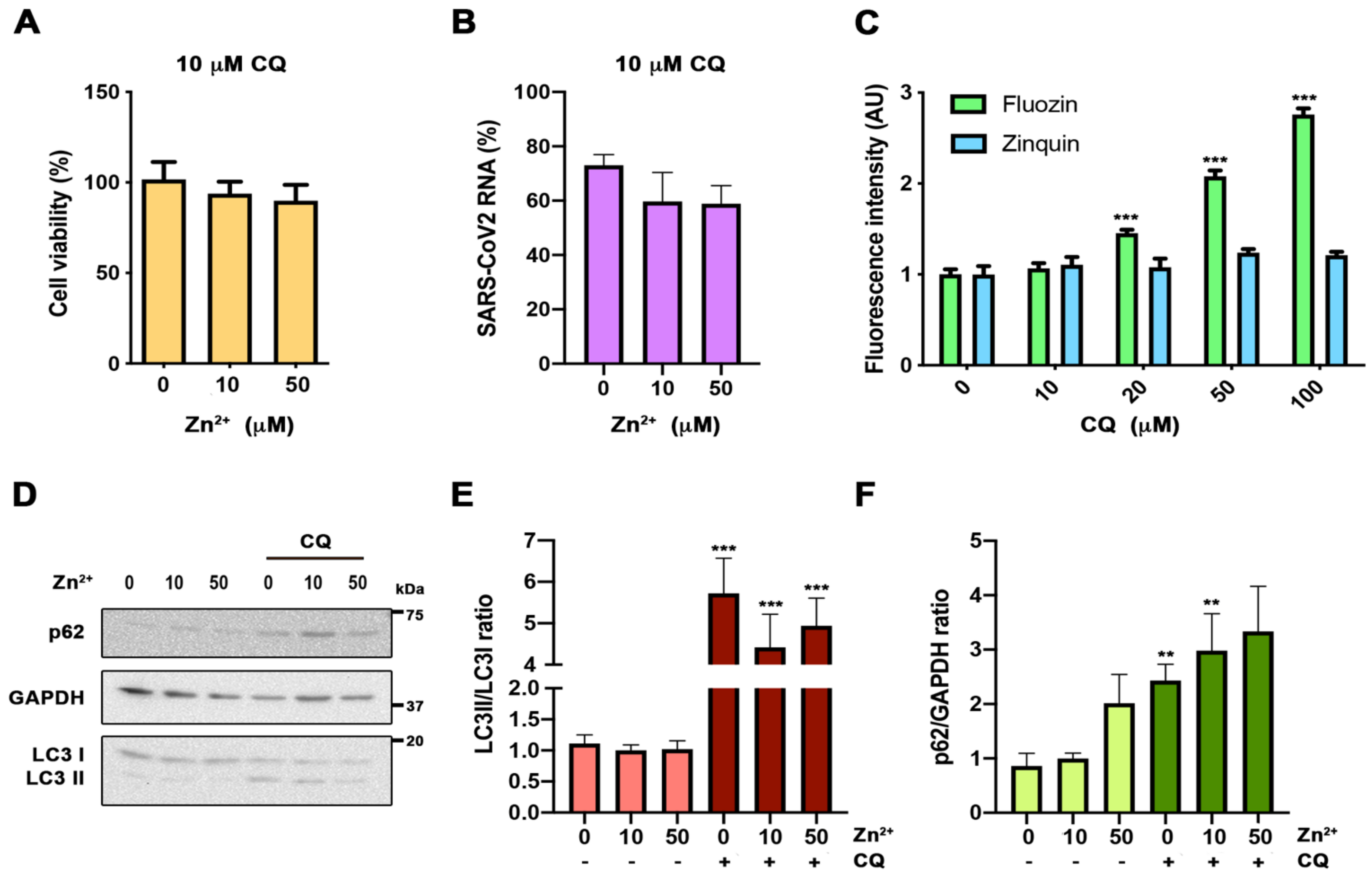Low Zinc Levels at Admission Associates with Poor Clinical Outcomes in SARS-CoV-2 Infection
Abstract
1. Introduction
2. Materials and Methods
2.1. Study Design and Participants
2.2. Procedures
2.3. Definitions
2.3.1. Time to Recovery (TR)
2.3.2. Clinical Severity
2.3.3. Low Zinc Levels
2.4. Cell Culture
2.5. Zinc Measurements
2.6. Viability Assays
2.7. Virus Infection and Quantification
2.8. Western Blot
2.9. Statistical Analysis
3. Results
3.1. Influence of SZC in COVID-19 Outcome
3.2. Impact of Cellular Zinc Content on SARS-CoV2 Expansion
3.3. Assessment of Zinc Properties as a Potentiator of Chloroquine’s Antiviral Action
4. Discussion
5. Conclusions
Supplementary Materials
Author Contributions
Funding
Institutional Review Board Statement
Informed Consent Statement
Data Availability Statement
Acknowledgments
Conflicts of Interest
References
- Prasad, A.S. Discovery of human zinc deficiency: Its impact on human health and disease. Adv. Nutr. 2013, 4, 176–190. [Google Scholar] [CrossRef]
- Gammoh, N.Z.; Rink, L. Zinc in infection and inflammation. Nutrients 2017, 9, 624. [Google Scholar] [CrossRef]
- Beck, F.W.; Prasad, A.S.; Kaplan, J.; Fitzgerald, J.T.; Brewer, G.J. Changes in cytokine production and T cell subpopulations in experimentally induced zinc-deficient humans. Am. J. Physiol. 1997, 272, E1002–E1007. [Google Scholar] [CrossRef]
- Jarosz, M.; Olbert, M.; Wyszogrodzka, G.; Młyniec, K.; Librowski, T. Antioxidant and anti-inflammatory effects of zinc. Zinc-dependent NF-jB signaling. Inflammopharmacology 2017, 25, 11–24. [Google Scholar] [CrossRef]
- Wessels, I.; Haase, H.; Engelhardt, G.; Rink, L.; Uciechowski, P. Zinc deficiency induces production of the proinflammatory cytokines IL-1β and TNFα in promyeloid cells via epigenetic and redox-dependent mechanisms. J. Nutr. Biochem. 2013, 24, 289–297. [Google Scholar] [CrossRef]
- Hasan, R.; Rink, L.; Haase, H. Zinc signals in neutrophil granulocytes are required for the formation of neutrophil extracellular traps. Innate Immun. 2013, 19, 253–264. [Google Scholar] [CrossRef] [PubMed]
- Hasan, R.; Rink, L.; Haase, H. Chelation of Free Zn2+ Impairs Chemotaxis, Phagocytosis, Oxidative Burst, Degranulation, and Cytokine Production by Neutrophil Granulocytes. Biol. Trace Elem. Res. 2016, 171, 79–88. [Google Scholar] [CrossRef] [PubMed]
- Science, M.; Johnstone, J.; Roth, D.E.; Guyatt, G.; Loeb, M. Zinc for the treatment of the common cold: A systematic review and meta-analysis of randomized controlled trials. CMAJ 2012, 184, E551–E561. [Google Scholar] [CrossRef] [PubMed]
- Read, S.A.; Obeid, S.; Ahlenstiel, C.; Ahlenstiel, G. The Role of Zinc in Antiviral Immunity. Adv. Nutr. 2019, 10, 696–710. [Google Scholar] [CrossRef]
- Te Velthuis, A.J.W.; van den Worm, S.H.E.; Sims, A.C.; Baric, R.S.; Snijder, E.J.; van Hemert, M.J. Zn(2+) inhibits coronavirus and arterivirus RNA polymerase activity in vitro and zinc ionophores block the replication of these viruses in cell culture. PLoS Pathog. 2010, 6, e1001176. [Google Scholar] [CrossRef] [PubMed]
- Subbe, C.P.; Davies, R.G.; Williams, E.; Rutherford, P.; Gemmell, L. Effect of introducing the Modified Early Warning score on clinical outcomes, cardio-pulmonary arrests and intensive care utilisation in acute medical admissions. Anaesthesia 2003, 58, 797–802. [Google Scholar] [CrossRef]
- Wessells, K.R.; King, J.C.; Brown, K.H. Development of a Plasma Zinc Concentration Cutoff to Identify Individuals with Severe Zinc Deficiency Based on Results from Adults Undergoing Experimental Severe Dietary Zinc Restriction and Individuals with Acrodermatitis Enteropathica. J. Nutr. 2014, 144, 1204–1210. [Google Scholar] [CrossRef]
- Liu, J.; Cao, R.; Xu, M.; Wang, X.; Zhang, H.; Hu, H.; Li, Y.; Hu, Z.; Zhong, W.; Wang, M. Hydroxychloroquine, a less toxic derivative of chloroquine, is effective in inhibiting SARS-CoV-2 infection in vitro. Cell Discov. 2020, 6, 16. [Google Scholar] [CrossRef]
- Yao, X.; Ye, F.; Zhang, M.; Cui, C.; Huang, B.; Niu, P.; Liu, X.; Zhao, L.; Dong, E.; Song, C.; et al. In Vitro Antiviral Activity and Projection of Optimized Dosing Design of Hydroxychloroquine for the Treatment of Severe Acute Respiratory Syndrome Coronavirus 2 (SARS-CoV-2). Clin. Infect. Dis. 2020, 71, 732–739. [Google Scholar] [CrossRef]
- Xue, J.; Moyer, A.; Peng, B.; Wu, J.; Hannafon, B.N.; Ding, W.-Q. Chloroquine is a zinc ionophore. PLoS ONE 2014, 9, e109180. [Google Scholar] [CrossRef] [PubMed]
- Derwand, R.; Scholz, M.; Zelenko, V.; York, N. COVID-19 outpatients—Early risk-stratified treatment with zinc plus low dose hydroxychloroquine and azithromycin: A retrospective case series study. Int. J. Antimicrob. Agents 2020, 56, 106214. [Google Scholar] [CrossRef] [PubMed]
- Carlucci, P.M.; Ahuja, T.; Petrilli, C.; Rajagopalan, H.; Jones, S.; Rahimian, J. Zinc sulfate in combination with a zinc ionophore may improve outcomes in hospitalized COVID-19 patients. J. Med. Microbiol. 2020, 69, 1228–1234. [Google Scholar] [CrossRef] [PubMed]
- Mauthe, M.; Orhon, I.; Rocchi, C.; Zhou, X.; Luhr, M.; Hijlkema, K.J.; Coppes, R.P.; Engedal, N.; Mari, M.; Reggiori, F. Chloroquine inhibits autophagic flux by decreasing autophagosome-lysosome fusion. Autophagy 2018, 14, 1435–1455. [Google Scholar] [CrossRef]
- Gorshkov, K.; Chen, C.Z.; Bostwick, R.; Rasmussen, L.; Xu, M.; Pradhan, M.; Tran, B.N.; Zhu, W.; Shamim, K.; Huang, W.; et al. The SARS-CoV-2 cytopathic effect is blocked with autophagy modulators. bioRxiv 2020. [Google Scholar] [CrossRef]
- Jothimani, D.; Kailasam, E.; Danielraj, S.; Nallathambi, B.; Ramachandran, H.; Sekar, P.; Manoharan, S.; Ramani, V.; Narasimhan, G.; Kaliamoorthy, I.; et al. COVID-19: Poor outcomes in patients with zinc deficiency. Int. J. Infect. Dis. 2020, 100, 343–349. [Google Scholar] [CrossRef] [PubMed]
- Heller, R.A.; Sun, Q.; Hackler, J.; Seelig, J.; Seibert, L.; Cherkezov, A.; Minich, W.B.; Seemann, P.; Diegmann, J.; Pilz, M.; et al. Prediction of survival odds in COVID-19 by zinc, age and selenoprotein P as composite biomarker. Redox Biol. 2021, 38, 101764. [Google Scholar] [CrossRef] [PubMed]
- Yasuda, H.; Tsutsui, T. Infants and elderlies are susceptible to zinc deficiency. Sci. Rep. 2016, 6, 21850. [Google Scholar] [CrossRef]
- Epidemiology Working Group for NCIP Epidemic Response, Chinese Center for Disease Control and Prevention. The epidemiological characteristics of an outbreak of 2019 novel coronavirus diseases (COVID-19) in China. Zhonghua Liu Xing Bing Xue Za Zhi 2020, 41, 145–151. [Google Scholar]
- Chen, G.; Wu, D.; Guo, W.; Cao, Y.; Huang, D.; Wang, H.; Wang, T.; Zhang, X.; Chen, H.; Yu, H.; et al. Clinical and immunological features of severe and moderate coronavirus disease 2019. J. Clin. Investig. 2020, 130, 2620–2629. [Google Scholar] [CrossRef]
- Besecker, B.Y.; Exline, M.C.; Hollyfield, J.; Phillips, G.; DiSilvestro, R.A.; Wewers, M.D.; Knoell, D.L. A comparison of zinc metabolism, inflammation, and disease severity in critically ill infected and noninfected adults early after intensive care unit admission. Am. J. Clin. Nutr. 2011, 93, 1356–1364. [Google Scholar] [CrossRef]
- Wong, C.P.; Dashner-Titus, E.J.; Alvarez, S.C.; Chase, T.T.; Hudson, L.G.; Ho, E. Zinc Deficiency and Arsenic Exposure Can Act Both Independently or Cooperatively to Affect Zinc Status, Oxidative Stress, and Inflammatory Response. Biol. Trace Elem. Res. 2019, 191, 370–381. [Google Scholar] [CrossRef] [PubMed]
- Prasad, A.S.; Beck, F.W.; Bao, B.; Fitzgerald, J.T.; Snell, D.C.; Steinberg, J.D.; Cardozo, L.J. Zinc supplementation decreases incidence of infections in the elderly: Effect of zinc on generation of cytokines and oxidative stress. Am. J. Clin. Nutr. 2007, 85, 837–844. [Google Scholar] [CrossRef]
- Bao, B.; Prasad, A.S.; Beck, F.W.; Fitzgerald, J.T.; Snell, D.; Bao, G.W.; Singh, T.; Cardozo, L.J. Zinc decreases C-reactive protein, lipid peroxidation, and inflammatory cytokines in elderly subjects: A potential implication of zinc as an atheroprotective agent. Am. J. Clin. Nutr. 2010, 91, 1634–1641. [Google Scholar] [CrossRef] [PubMed]
- Liuzzi, J.P.; Lichten, L.A.; Rivera, S.; Blanchard, R.K.; Aydemir, T.B.; Knutson, M.D.; Ganz, T.; Cousins, R.J. Interleukin-6 regulates the zinc transporter Zip14 in liver and contributes to the hypozincemia of the acute-phase response. Proc. Natl. Acad. Sci. USA 2005, 102, 6843–6848. [Google Scholar] [CrossRef]
- Cavalcanti, A.B.; Zampieri, F.G.; Rosa, R.G.; Azevedo, L.C.; Veiga, V.C.; Avezum, A.; Damiani, L.P.; Marcadenti, A.; Kawano-Dourado, L.; Lisboa, T.; et al. Hydroxychloroquine with or without Azithromycin in Mild-to-Moderate COVID-19. N. Engl. J. Med. 2020, 383, 2041–2052. [Google Scholar] [CrossRef]
- Boulware, D.R.; Pullen, M.; Bangdiwala, A.S.; Pastick, K.; Lofgren, S.; Okafor, E.C.; Skipper, C.P.; Nascene, A.A.; Nicol, M.R.; Abassi, M.; et al. A Randomized Trial of Hydroxychloroquine as Postexposure Prophylaxis for COVID-19. N. Engl. J. Med. 2020, 383, 517–525. [Google Scholar] [CrossRef] [PubMed]
- Derwand, R.; Scholz, M. Does zinc supplementation enhance the clinical efficacy of chloroquine/hydroxychloroquine to win today’s battle against COVID-19? Med. Hypotheses 2020, 142, 109815. [Google Scholar] [CrossRef] [PubMed]



| Overall | <50 µg/dL | ≥50 µg/dL | p-Value | ||||
|---|---|---|---|---|---|---|---|
| Cohort Characteristics | n = 249 | n = 58 | n = 191 | ||||
| Median age, years (IQR) | 65 | (54–75) | 65 | (59–75) | 64 | (53–74) | 0.363 |
| Male sex (%) | 127 | −51% | 30 | −51% | 97 | −51% | 0.929 |
| Comorbidities | |||||||
| Current smoker (%) | 23 | −9.30% | 4 | −7% | 19 | −10% | 0.482 |
| Hypertension (%) | 141 | −56% | 33 | −57% | 108 | −57% | 0.962 |
| Diabetes mellitus (%) | 53 | −21% | 17 | −29% | 36 | −19% | 0.088 |
| Chronic lung disease (%) | 22 | −9% | 9 | −16% | 13 | −7% | 0.041 |
| Chronic heart disease (%) | 37 | −14% | 11 | −19% | 26 | −14% | 0.315 |
| Chronic renal disease (%) | 70 | −12% | 22 | −38% | 48 | −25% | 0.058 |
| Chronic liver disease (%) | 18 | −7% | 1 | −2% | 17 | −9% | 0.065 |
| Dementia (%) | 8 | −3% | 2 | −3% | 6 | −3% | 0.908 |
| HIV infection (%) | 5 | −2% | 1 | −2% | 4 | −2% | 0.865 |
| Active cancer (%) | 7 | −3% | 3 | −5% | 4 | −2% | 0.214 |
| ACE inhibitors (%) | 61 | −24% | 12 | −21% | 49 | −26% | 0.441 |
| Charlson Comorbidy Index, median (IQR) | 1 | (0–3) | 1 | (0–3) | 1 | (0–2) | 0.247 |
| Symptoms at onset | |||||||
| Median days since syntoms onset (IQR) | 7 | (4–9) | 6 | (3–7) | 7 | (5–10) | 0.005 |
| Dyspnoea (%) | 151 | −60% | 42 | −72% | 109 | −57% | 0.036 |
| Fever (%) | 203 | −81% | 45 | −77% | 158 | −82% | 0.377 |
| Cough (%) | 198 | −79% | 43 | −74% | 155 | −81% | 0.246 |
| Diarrhea (%) | 68 | −27% | 12 | −21% | 56 | −29% | 0.196 |
| Clinical markers at onset | |||||||
| Median C-reactive protein mg/dL (IQR) | 7.5 | (3.5–15.2) | 14.6 | (5–24) | 7 | (3–13) | 0.037 |
| Median lymphocyte count/mL (IQR) | 1.02 | (0.71–1.4) | 0.82 | (0.57–1.18) | 1.1 | (0.78–1.48) | 0.598 |
| Median interleukin (IL)-6 pg/mL (IQR) | 42 | (15–89) | 77 | (39–145) | 32 | (11–71) | <0.001 |
| Median lactate dehydrogenase UI/l (IQR) | 288 | (241–345) | 356 | (275–483) | 274 | (231–362) | 0.001 |
| Median D-dimer UI/l (IQR) | 800 | (470–1450) | 935 | (540–1700) | 800 | (460–1215) | 0.048 |
| Median PaO2FiO2 ratio (IQR) | 177 | (100–299) | 124 | (91–181) | 219 | (106–314) | <0.001 |
| Median modified early warning score (MEWS) (IQR) | 2 | (1–3) | 2 | (2–3) | 2 | (1–3) | 0.005 |
| Median serum zinc, mcg/mL (IQR) | 61 | (50–71) | 43 | (39–48) | 66 | (58–74) | <0.001 |
| Treatment | |||||||
| Hydroxycholoroquine (%) | 248 | −99.50% | 58 | −100% | 190 | −99% | 0.372 |
| Azythromicin (%) | 231 | −95% | 57 | −95% | 174 | −95% | 0.766 |
| Tocilizumab (%) | 55 | −23% | 23 | −40% | 32 | −17% | <0.001 |
| Dexamethasone (%) | 64 | −26% | 24 | −41% | 40 | −21% | <0.001 |
| Methylprednisolone (%) | 59 | −24% | 26 | −45% | 33 | −17% | <0.001 |
| Clinical Outcomes | |||||||
| Median Time to clinical recovery days (IQR) | 10 | (6–18) | 25 | (14–36) | 8 | (5–14) | <0.001 |
| Intensive care unit (ICU) admission (%) | 70 | −28% | 36 | −62% | 34 | −18% | <0.001 |
| Death (%) | 21 | −9% | 12 | −21% | 9 | −5% | <0.001 |
Publisher’s Note: MDPI stays neutral with regard to jurisdictional claims in published maps and institutional affiliations. |
© 2021 by the authors. Licensee MDPI, Basel, Switzerland. This article is an open access article distributed under the terms and conditions of the Creative Commons Attribution (CC BY) license (http://creativecommons.org/licenses/by/4.0/).
Share and Cite
Vogel-González, M.; Talló-Parra, M.; Herrera-Fernández, V.; Pérez-Vilaró, G.; Chillón, M.; Nogués, X.; Gómez-Zorrilla, S.; López-Montesinos, I.; Arnau-Barrés, I.; Sorli-Redó, M.L.; et al. Low Zinc Levels at Admission Associates with Poor Clinical Outcomes in SARS-CoV-2 Infection. Nutrients 2021, 13, 562. https://doi.org/10.3390/nu13020562
Vogel-González M, Talló-Parra M, Herrera-Fernández V, Pérez-Vilaró G, Chillón M, Nogués X, Gómez-Zorrilla S, López-Montesinos I, Arnau-Barrés I, Sorli-Redó ML, et al. Low Zinc Levels at Admission Associates with Poor Clinical Outcomes in SARS-CoV-2 Infection. Nutrients. 2021; 13(2):562. https://doi.org/10.3390/nu13020562
Chicago/Turabian StyleVogel-González, Marina, Marc Talló-Parra, Víctor Herrera-Fernández, Gemma Pérez-Vilaró, Miguel Chillón, Xavier Nogués, Silvia Gómez-Zorrilla, Inmaculada López-Montesinos, Isabel Arnau-Barrés, Maria Luisa Sorli-Redó, and et al. 2021. "Low Zinc Levels at Admission Associates with Poor Clinical Outcomes in SARS-CoV-2 Infection" Nutrients 13, no. 2: 562. https://doi.org/10.3390/nu13020562
APA StyleVogel-González, M., Talló-Parra, M., Herrera-Fernández, V., Pérez-Vilaró, G., Chillón, M., Nogués, X., Gómez-Zorrilla, S., López-Montesinos, I., Arnau-Barrés, I., Sorli-Redó, M. L., Horcajada, J. P., García-Giralt, N., Pascual, J., Díez, J., Vicente, R., & Güerri-Fernández, R. (2021). Low Zinc Levels at Admission Associates with Poor Clinical Outcomes in SARS-CoV-2 Infection. Nutrients, 13(2), 562. https://doi.org/10.3390/nu13020562







